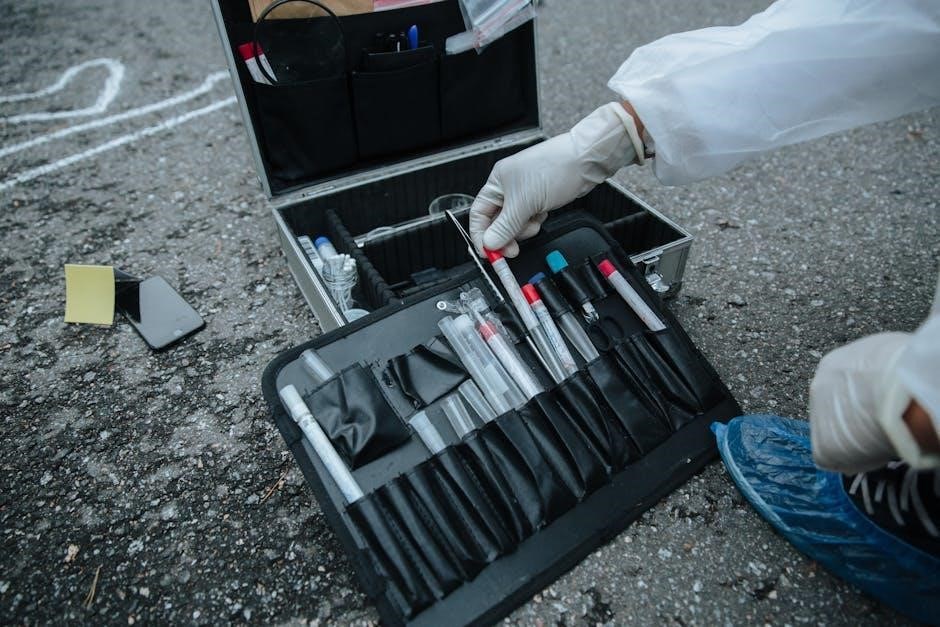Definition and Overview of Forensic Science
Forensic science is defined as the application of scientific principles to investigate crimes and help solve legal issues‚ with a focus on collecting and analyzing evidence. The overview of forensic science involves various disciplines‚ including biology‚ chemistry‚ and physics‚ to examine physical evidence and provide expert testimony in court. According to online resources‚ forensic science fundamentals and investigations involve the use of scientific methods to analyze evidence‚ such as DNA‚ fingerprints‚ and other physical evidence‚ to help investigators piece together the events surrounding a crime. The goal of forensic science is to provide objective‚ unbiased information to aid in the investigation and prosecution of crimes‚ and to help bring justice to victims and their families. This definition and overview provide a foundation for understanding the role of forensic science in investigations and its importance in the legal system.
Importance of Forensic Science in Investigations
The importance of forensic science in investigations cannot be overstated‚ as it provides a crucial link between the crime scene and the perpetrator. Forensic science helps investigators to reconstruct the events surrounding a crime‚ identify suspects‚ and gather evidence to build a case. By analyzing physical evidence‚ such as DNA‚ fingerprints‚ and other traces‚ forensic scientists can help to solve crimes that might otherwise remain unsolved. The use of forensic science in investigations also helps to exonerate innocent individuals and bring justice to victims and their families. Additionally‚ forensic science plays a critical role in cold case investigations‚ where new technologies and techniques can be applied to re-examine evidence and potentially solve crimes that have gone unsolved for years. This importance is reflected in the growing reliance on forensic science in modern investigations.

Forensic Science Fundamentals
Forensic science fundamentals include basic knowledge of crime scene analysis and evidence collection methods online for investigations purposes daily using various techniques always.
Basic Knowledge in Crime Investigation
Basic knowledge in crime investigation is essential for forensic scientists to understand the principles of evidence collection and analysis. This knowledge includes the understanding of crime scene protocols‚ evidence handling‚ and laboratory procedures. Forensic scientists must also be familiar with various investigative techniques‚ such as fingerprint analysis‚ DNA profiling‚ and ballistics. Additionally‚ they must have a basic understanding of human anatomy‚ physiology‚ and psychology to interpret evidence and reconstruct crime scenes. The internet provides a wealth of information on forensic science fundamentals and investigations‚ including online courses‚ tutorials‚ and downloadable PDF resources. These resources can help forensic scientists stay up-to-date with the latest techniques and methodologies in the field. By combining theoretical knowledge with practical skills‚ forensic scientists can effectively investigate crimes and bring perpetrators to justice‚ using online resources and pdf materials for investigations.
Role of Forensic Science in Crime Solving
The role of forensic science in crime solving is crucial‚ as it provides objective and unbiased evidence to aid in investigations. Forensic scientists analyze physical evidence‚ such as DNA‚ fingerprints‚ and footprints‚ to link suspects to crime scenes. This evidence can also be used to exonerate innocent individuals‚ ensuring justice is served. By applying scientific principles and techniques‚ forensic scientists help investigators reconstruct crimes and identify perpetrators. The internet offers a range of resources‚ including PDF guides and online tutorials‚ to help forensic scientists develop their skills and stay updated on the latest methods and technologies. Effective use of forensic science in crime solving has led to the resolution of numerous high-profile cases‚ demonstrating its significance in the pursuit of justice and public safety‚ with many resources available online for investigations and research purposes.

Investigations and Evidence Collection
Investigations involve collecting and analyzing evidence using methods and techniques for investigations purposes online effectively.
Methods of Evidence Collection and Analysis
Methods of evidence collection and analysis are crucial in forensic science‚ involving various techniques such as DNA analysis‚ fingerprinting‚ and chemical testing.
These methods help investigators to collect and analyze evidence from crime scenes‚ which can include physical evidence like hair‚ fibers‚ and fingerprints‚ as well as digital evidence like emails and phone records.
The analysis of this evidence can help to identify suspects‚ reconstruct crimes‚ and solve cases.
Forensic scientists use specialized equipment and software to analyze evidence‚ including microscopes‚ spectrometers‚ and DNA sequencing instruments.
They also use statistical methods and computer simulations to interpret the results of their analyses and draw conclusions about the evidence.
By combining these methods and techniques‚ forensic scientists can help to build a comprehensive picture of a crime and bring perpetrators to justice.
The use of these methods has become increasingly important in forensic science and investigations.
Types of Evidence in Forensic Science
There are several types of evidence in forensic science‚ including physical‚ biological‚ and digital evidence.
Physical evidence can include items like weapons‚ fingerprints‚ and footprints‚ while biological evidence can include DNA‚ blood‚ and hair.
Digital evidence can include emails‚ text messages‚ and computer files.
Each type of evidence requires specialized handling and analysis to ensure its integrity and admissibility in court.
Forensic scientists use various techniques to collect and analyze evidence‚ including microscopy‚ spectroscopy‚ and chromatography.
The type of evidence collected can depend on the nature of the crime and the circumstances of the investigation.
By understanding the different types of evidence and how to collect and analyze them‚ forensic scientists can help to solve crimes and bring perpetrators to justice‚ providing valuable insights into the investigation process and helping to build a case.
The analysis of evidence is a critical component of forensic science.

Forensic Science and Technology
Forensic science and technology integrate to enhance investigations and analyses using digital tools and methods for efficient evidence collection purposes online always.
Advancements in Forensic Science and Technology
Advancements in forensic science and technology have significantly improved the field of investigations‚ enabling experts to analyze evidence more efficiently and accurately. The integration of digital tools and methods has enhanced the process of evidence collection and analysis. With the help of advanced technology‚ forensic scientists can now reconstruct crime scenes‚ analyze DNA samples‚ and identify suspects more effectively. The use of artificial intelligence and machine learning algorithms has also been introduced in forensic science‚ allowing for faster and more accurate analysis of evidence. Furthermore‚ advancements in forensic science and technology have led to the development of new techniques and methods‚ such as 3D printing and virtual reality‚ which are being used to recreate crime scenes and analyze evidence. These advancements have greatly improved the field of forensic science and have helped to solve complex cases. Overall‚ the integration of technology has revolutionized the field of forensic science.
Applications of Forensic Science in Real-Life Scenarios
Forensic science has numerous applications in real-life scenarios‚ including criminal investigations‚ civil cases‚ and environmental monitoring. The use of forensic science in real-life scenarios has led to the resolution of complex cases‚ such as murders‚ thefts‚ and accidents. Forensic scientists use various techniques‚ including DNA analysis‚ fingerprinting‚ and ballistics‚ to analyze evidence and reconstruct crime scenes. Additionally‚ forensic science is used in disaster investigations‚ such as plane crashes and natural disasters‚ to identify victims and determine the cause of the disaster. The application of forensic science in real-life scenarios has also led to the development of new technologies and methods‚ such as digital forensic analysis and forensic engineering. These applications have greatly improved the field of forensic science and have helped to solve complex cases‚ bringing justice to victims and их families‚ and improving public safety and security measures.

and Future Directions
Challenges and Opportunities in Forensic Science
Forensic science fundamentals and investigations face numerous challenges‚ including limited resources and evolving technologies‚ which can hinder the accuracy and reliability of evidence collection and analysis methods.
Despite these challenges‚ there are opportunities for growth and development‚ such as advancements in digital forensics and the integration of artificial intelligence in investigative processes.
The application of forensic science in real-life scenarios presents a complex interplay of scientific principles‚ legal frameworks‚ and social implications‚ requiring a comprehensive understanding of the subject matter and its limitations.
Furthermore‚ the increasing availability of online resources‚ such as the forensic science fundamentals and investigations pdf‚ has facilitated access to information and educational materials‚ enabling professionals and students to stay updated on the latest developments and best practices in the field.
Overall‚ the challenges and opportunities in forensic science underscore the need for continuous innovation‚ collaboration‚ and critical evaluation of existing methods and techniques.
